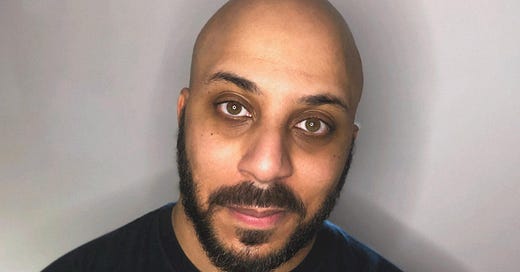Adem Holness: “My identity as a Black person is not based on my experience of racism”
The curator on shifting culture and not tying Britishness to whiteness
Hi, welcome back to Mixed Messages! This week I’m speaking to Adem Holness, who is of Jamaican and Turkish Cypriot heritage. Adem is one of 40 people in the inaugural year of the PRS Foundation’s POWER UP network, an initiative launched to address anti-Black racism and racial disparities in the music sector. Representing Black talent across the UK, from all different genres, I’m excited to speak to mixed-Black participants over the next few weeks. Next up, music curator at Horniman Museum and Gardens Adem Holness.
How do you define your ethnicity?
I describe myself as a Black mixed-race person. My parents are Turkish Cypriot and Jamaican, but British-born. People say to me, “what an unusual mix!” I just think, “have you been to North London before?”
Do you call yourself Black because of your own self identity or how others perceive you?
I think it’s a mixture. I was told I was Black when I was younger in the same way I was told my name.
My identity as a Black person is not solely based on my experience of racism. That is a huge factor of what it means to be Black, but I don’t feel any less Jamaican than my cousins who might look different to me. My Turkishness, my gayness, my class; none of those things negate my Blackness.
Do you think of your Turkish Cypriot side as white?
I also identify as Middle Eastern. I’d say they’re white Middle Eastern, but I don’t know the answer to that question right now. I’m pretty sure my mum would say ‘white other’.
Have you enjoyed culture from all of your heritages?
Jamaican culture is the most dominant in my life, as it is for most people with Jamaican heritage. It’s also how the world identifies me. I’ve connected through food (I always used to put a Jamaican spin on food tech at school) and music, the latter of which has been a massive factor in my life.
Working in culture, and particularly for a museum, there’s a certain idea of culture, but my idea of culture has been around different types of exchanges. My team at Horniman Museum looks after the most comprehensive collection of instruments in the country. My job is to connect these instruments with real people, strengthening links between collections and our spaces to the public, as well as engaging people on the spectrum of Black music; it’s not a monolithic thing.
I often feel disconnected from my Indian heritage because I don’t enjoy the same food, music or media as my family – do you think that idea needs to change?
For people who think they’re not connected to their culture because they don’t enjoy the culture their grandparents did, I’d say it’s generational, too. Our way of being second or third generation is different. For me, being Jamaican means loving bashment, which is not what my grandparents would be into. They’d be horrified by the music I listen to. It’s OK to define the culture for yourself.
My partner is Greek Cypriot, and I have a particular idea of what it means to be a North London Cypriot person at a particular time based on how I grew up. But really, families are so different. It can be easy for a stereotype to dominate what we think of as an ethnic identity. It’s not that cut and dry.
Have you always been comfortable in your identity?
My parents are divorced, and we moved from North London to Hertfordshire when I was 10, where there was very little cultural or ethnic diversity. That was quite a confronting experience, but I still had a strong relationship with North London and my family.
I’m not somebody where the dual aspects of their identity have felt in conflict with each other. I never felt like I needed to be one thing or the other. I think for some people, the conversation conflates whiteness and Britishness. Because my mum’s not English, I don’t get wrapped up in that.
Do you think the conversation around being mixed needs to change?
Part of the challenge for me is having a conversation specifically about the mixed-Black experience, the nuances of what it means to be mixed within that. We need to acknowledge the inherent privilege in that compared to other types of Black people.
As somebody who is perceived as a Black man, the way I dress will make a massive impact on how I’m treated, like if I wear a hoodie versus a Spice Girls or Celine Dion t-shirt. Those outfits lead to completely different interactions. Being perceived as queer will completely change the way people will make assumptions about me based on my race.
If you could sum up being mixed in a word, which would you pick?
Mine.
To connect with Adem’s work, visit 696 at Horniman Museum and Gardens. The project, platforming the best new Afrobeat, Jazz, Grime, Rap, R&B, Reggae and Soul music, focuses on championing music genres (and the people working in them) that have been disproportionately affected by bias in legislation.
Next week, I’ll be talking to Loretta Andrews, founder of Safe Music Management. Subscribe to get Mixed Messages in your inbox on Monday!
Enjoy Mixed Messages? Support me on Ko-Fi so I can continue to grow this newsletter! My new goal is to amplify the newsletter for the first anniversary of Mixed Messages.
Mixed Messages is a weekly exploration of the mixed-race experience, from me, Isabella Silvers. My mom is Punjabi Indian (by way of East Africa) and my dad is White British, but finding my place between these two cultures hasn’t always been easy. That’s why I started Mixed Messages, where each week I’ll speak to a prominent mixed voice to delve into what it really feels like to be mixed.







